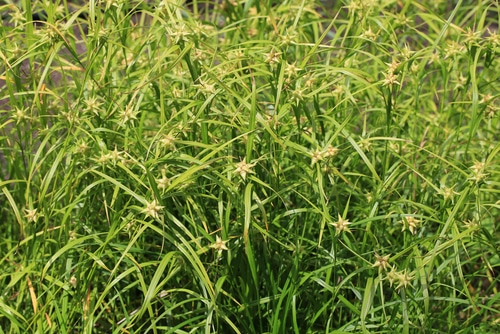13 Flowering Vines to Grow in Tennessee
Lively up your garden by adding some lateral growers. The following 13 flowering vines thrive in Tennessee,
1. Crossvine (Bignonia Capreolata)
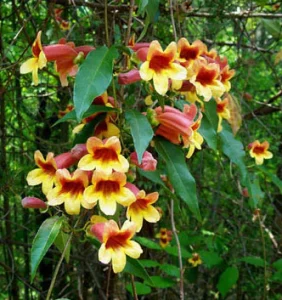
This impressive vine produces an abundance of trumpet-shaped flowers in early spring. The remarkable blooms can be up to 2 inches long and 1 1/2 inches wide. The most common variety has bright yellow petals and burnt orange pistils. These delicate flowers hang in clusters at the end of foliage-heavy stems. The plant goes on to produce pod-like fruits in late summer. These pods may be anywhere from 4 to 8 inches in length. They can be saved and replanted.
Crossvine (Bignonia capreolata) thrives in sunny, dry areas. Be sure to amend your soil to ensure that it is well-draining and mildly acidic. These are the conditions that crossvine prefers.
The crossvine’s flowers put on a big show. Their trumpet-like form and bright colors are a huge draw for native hummingbirds and butterflies. The evergreen’s shiny, green foliage is also quite beautiful. It typically attracts deer and other grazing animals. The dense thickets make excellent privacy screens and shade covers.
2. Spurred Butterfly Pea (Centrosema Virginianum)
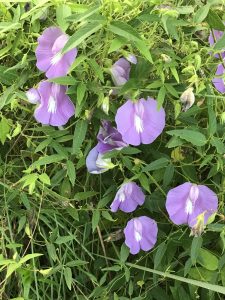
Spurred butterfly pea is a flowering vine that’s native to the Southeast. It’s a delicate vine that produces fragrant flowers and grass-like foliage. The occasionally clustered blooms may be blue, purple, or pink. The flowers bloom in late summer and only last for a day.
This charming plant can grow to be 6 to 12 feet tall in a single growing season. It’s a vigorous climber that appreciates guidance and support. Plant yours by an arbor, trellis, pergola, or fence. Ensure that your soil is acidic and sandy. Watch for beneficial visitors, such as butterflies and bees.
3. Swamp Leatherflower (Clematis Crispa)
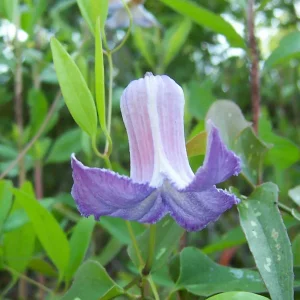
Swamp leatherflower, or curly clematis, is an herbaceous vine that produces delicate, green leaflets and purple and white flowers. The fragrant blooms droop from downward-facing stems. The bases of the flowers are hollow and cup-like. However, the outsides are ribbed. The tops of the blossoms feature four backward-curled petals. The plant typically produces two sets of flowers during each growing season. You can expect your swamp leatherflower to bloom in late summer or early fall.
Swamp leatherflower is native to the eastern United States. It’s an excellent pick for any Tennessee garden. It requires occasional watering and some shade. The soil around its roots should remain moist all day long. Mulch over its root base, and amend its soil with clay or loam. This will help to ensure that the plant produces an abundance of blooms.
4. Evening Trumpet Flower (Gelsemium Sempervirens)
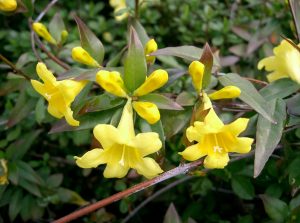
Evening trumpet flower, or Carolina jessamine, is an evergreen vine with trumpet-like, yellow flowers. The fragrant blooms grow in clusters at the ends of foliage-heavy stems. Evening trumpet flower vines can grow to be anywhere from 4 to 24 inches long. Its flowers arrive in early spring. We recommend that you plant yours near some sort of supportive structure, such as a fence or a piece of upright lattice.
The evening trumpet flower’s buds are immensely popular with mason bees. However, all parts of the plant are poisonous to mammals. On top of that, its nectar is poisonous to bumble bees.
The evening trumpet flower is native to the Southeast and is an excellent option for a Tennessee garden. The spindly vine is somewhat delicate. Ensure that yours is planted in fertile, moist soil. While this perennial vine can tolerate shade, it thrives in sunny conditions.
5. Dutchman’s Pipe (Aristolochia)
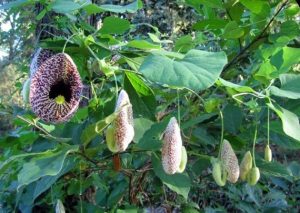
Dutchman’s pipe, or wild ginger, is a woody, climbing vine that grows wild through most parts of the eastern half of the country. It’s a mesmerizing vine with pipe-shaped, purple blooms and green, heart-shaped leaves. The blooms have an admittedly putrid scent that some people compare to rotting meat. You may want to consider this fact when before you consider propagating this plant. The good news is that the smell does not deter beneficial visitors. Dutchman’s pipe is a known host plant of swallowtail butterflies and a few other native insects.
This eye-catching plant can grow to be anywhere from 10 to 15 feet tall. It prefers to climb. As such, it should be propagated alongside some sort of lateral structure.
6. American Wisteria (Wisteria Frutescens)
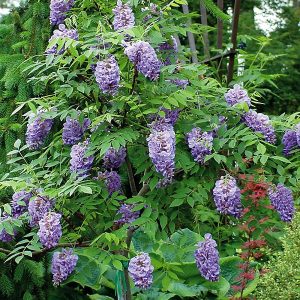
American wisteria is a lively vine with shiny, green leaves, and droopy, cone-shaped flowers. The vine’s shoots can grow to be anywhere from 15 to 30 feet long depending on its growing conditions. Multiple vines can be grown from a single rootstock. The flowers bloom repeatedly for three to four weeks. The blossoms, which are typically light purple or blue, give way to long seedpods in autumn.
American wisteria is a fast-grower that returns year after year. Since it can take several years for the plant to reach blooming age, we recommend that you propagate yours from already established cuttings. American wisteria thrives in full sun and poor soil. The plant’s heavy stem requires some sort of lateral support. Plant yours near a sturdy structure, such as a fence or railings.
American wisteria thrives in USDA hardiness zones 5 through 9. It’s the native alternative to the Chinese wisteria, an ornamental cultivar that is sold by major retailers.
7. Passionflower (Passiflora)
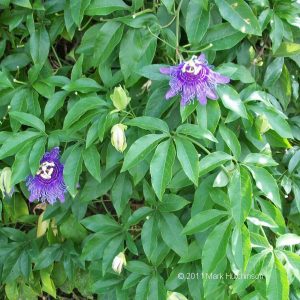
Passionflower, or maypop, is Tennessee’s state wildflower. This mesmerizing vine produces exotic-looking flowers. The daisy-like, purple blooms have small, whirly petals. Five stamens protrude from the flowers’ bullseye-like centers. The flowers are typically 1.5 to 3 inches in diameter. They are usually accompanied by rows of round, green leaves. The plant also produces yellow fruits called maypops. These edible berries pop when they’re chewed.
Maypop can grow to be 30 feet tall. The hearty perennial prefers full sun or partial shade and moist but well-draining soil. Plant yours in a spot where it can receive shade and support. This incredible plant will give you flowers between March and April and fruits between April and November. The above-ground portion of the plant dies each winter.
8. Heartleaf Peppervine (Ampelopsis Cordata)
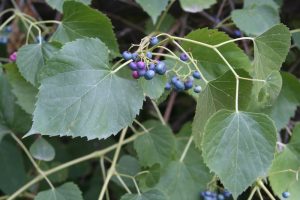
Heartleaf peppervine is a vigorous climber that is native to Tennessee and several other states in the Southeast. This trailing vine produces fruits that are similar to grapes. Green and white clusters of flowers precede the berries. The fruits, which also appear in clusters, ripen in late summer or early fall. The plant’s foliage is heart-shaped and toothy.
The vine sticks to objects with the help of small, spindly tendrils. It can grow to be anywhere from 12 to 36 feet long in a single season. This vigorous climber may not be something you want trailing along intricate fencing, as it can be difficult to remove. The thick foliage makes it an excellent privacy screen. The sweet, purple berries are beloved by birds and insects.
Heartleaf peppervine prefers partial shade and dry soil. While the berries look a lot like grapes, they are not safe for consumption.
9. Virgin’s Bower (Clematis Virginiana)
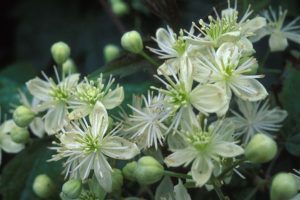
Virgin’s bower is an ornamental vine that is native to the eastern United States. This woody perennial grows in the woodlands and thickets of Tennessee and other Southeast states. It’s an aggressive climber that can grow to be 10 to 20 feet tall in a single season. Its daisy-like flowers grow in pyramid-like formations. The white and yellow blooms are accompanied by toothy, lobed leaves.
Virgin’s bower also goes by the name devil’s darning needles. This intriguing plant is a member of the buttercup family. It thrives in shady, moist conditions but is not all that particular about its surroundings.
10. Trumpet Honeysuckle (Lonicera Sempervirens)
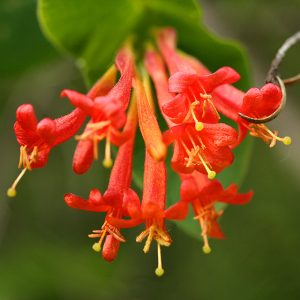
Trumpet honeysuckle is another fast-growing vine that is native to the Southeast. Trumpet honeysuckle produces an abundance of delicate, orange flowers. The trumpet-shaped blooms grow in clusters alongside the plant’s paddle-shaped leaves. The flowers and foliage grow from the plant’s extended stems.
Trumpet honeysuckle is a close relative of invasive Japanese honeysuckle. It can grow to be upwards of 15 feet tall and 6 feet wide in a year. The plant puts on an impressive show between June and September. Plant yours alongside arbors, trellises, and other decorative structures. Trumpet honeysuckle offers a welcome dose of color.
Trumpet honeysuckle does not have a strong smell. However, European honeysuckle (Lonicera periclymenum) and winter honeysuckle are two noninvasive alternatives with amazing fragrances and equally stunning blossoms.
11. Climbing hydrangea (Hydrangea Anomala)
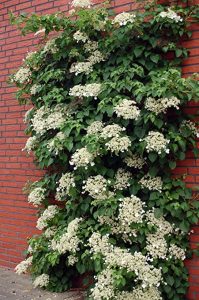
Climbing hydrangea is a deciduous, evergreen vine that’s native to the southeastern United States. This particular cultivar produces rich, green foliage and soft, white flowers. The woody vine has no trouble climbing up and sticking to a wide variety of surfaces, including but not limited to brick, metal, and wood.
The climbing hydrangea can grow to be 40 feet tall. Since the base of the plant does not produce foliage, we recommend that you plant it alongside tall ground cover or midsized shrubbery. Keep in mind that the climbing hydrangea’s thick trunk is capable of choking out neighboring plants, including young trees and shrubs. Care should be taken to ensure that the vine does wrap itself around high-valued plantings.
Decumaria barbara is a type fast-growing type of climbing hydrangea with shiny, green leaves and fragrant, white flowers. It grows naturally throughout parts of the eastern United States. Its lace-like flowers tend to attract all sorts of native pollinators.
This impressive vine attaches itself to structures by small aboveground roots. It can grow to be 30 feet tall in a year. This plant prefers moist, nutrient-dense soil. It does well in shade but can tolerate a few hours of sunlight.
12. Chocolate Vine (Akebia Quinata)
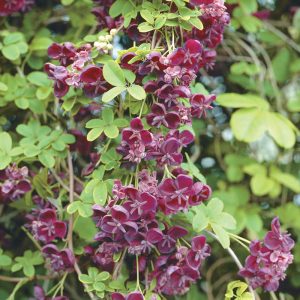
Chocolate vine is a fast-growing perennial that grows well in the Southeast. This cultivar’s purple flowers smell like, you guessed it, chocolate. The plant’s leaves are dark green and oval-shaped. It produces eggplant-like purple fruit in late summer. The plant’s produce is not safe for consumption. However, native birds and other animals tend to enjoy the vine’s berries.
13. American Bittersweet (Celastrus Scandens)
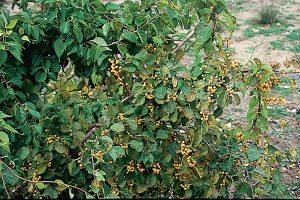
American bittersweet is a woody perennial that grows naturally throughout the eastern part of the country. This climbing vine wraps itself around trees and other structures. It produces an abundance of shiny, green leaves, semi-translucent, orange berries, and small, yellow flowers. Bittersweet flowers and berries are loved by birds and pollinators.
While this plant can be somewhat aggressive, it is manageable. Keep in mind that a single vine can grow to be 15 to 20 feet tall and 3 to 6 feet wide. Occasional trimming and training will help you to keep yours under control.
American bittersweet is native to central and eastern North America. It grows well in all of Tennessee’s hardiness zones.
We hope you enjoyed our rundown of the top flowering vines for Tennessee gardens! These impressive creepers and climbers will help you draw in all sorts of native birds and pollinators. Use yours along fences, arbors, and trellises. Enjoy the diverse collection of flowers and fruits that accompany these plants’ spindly stems!


